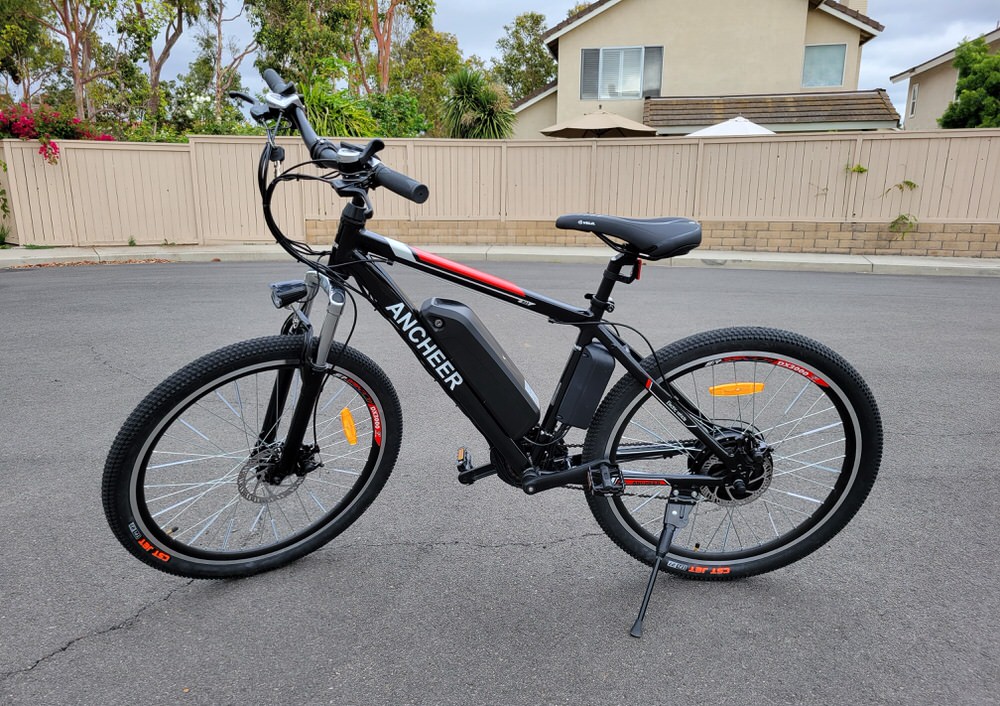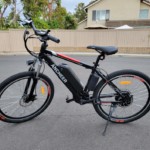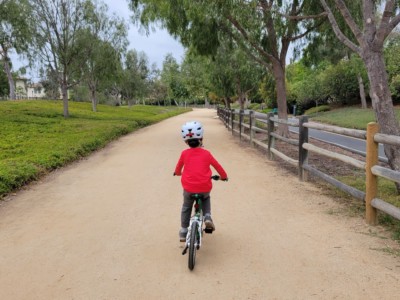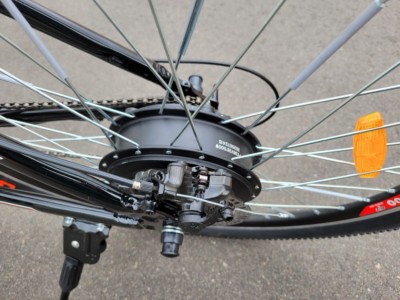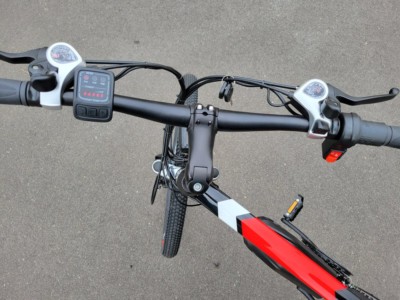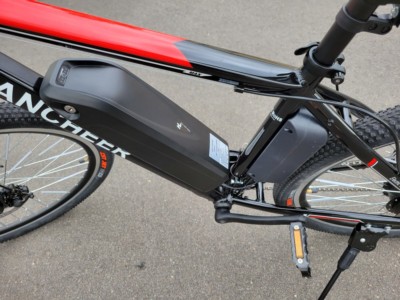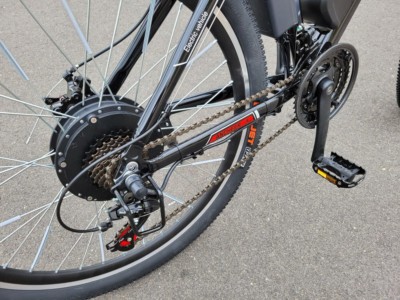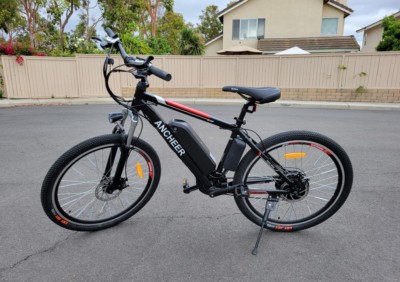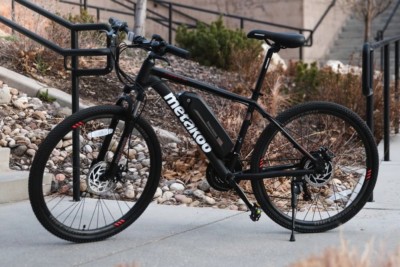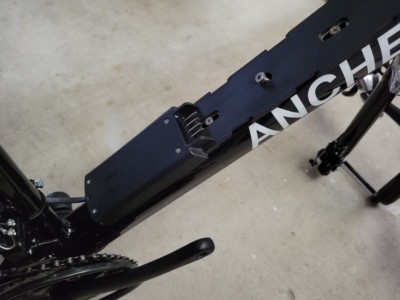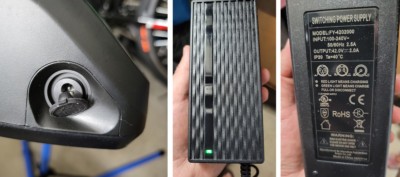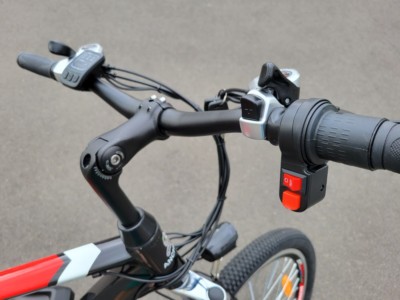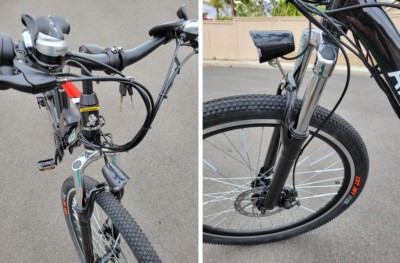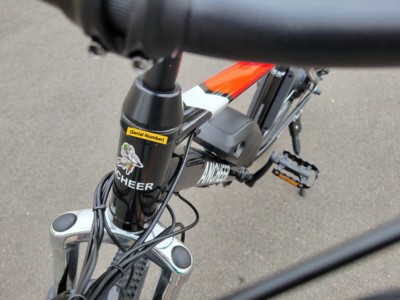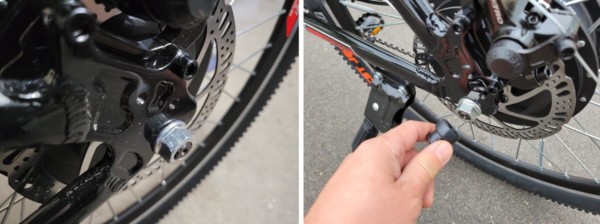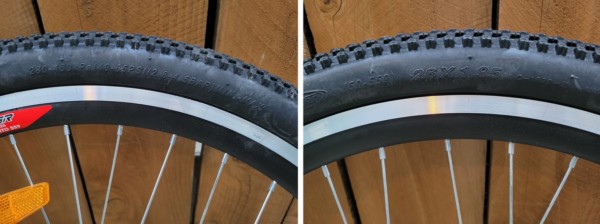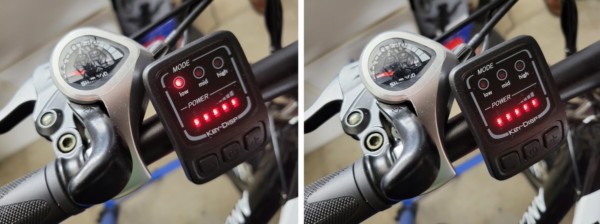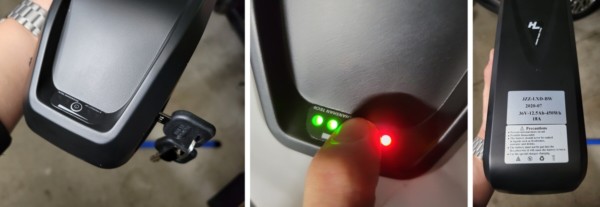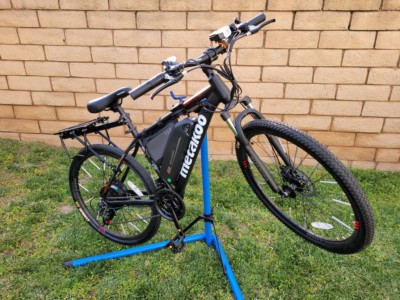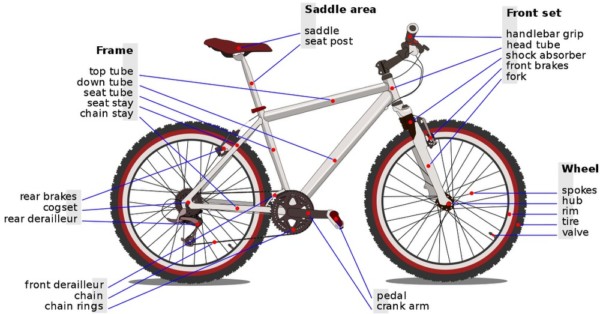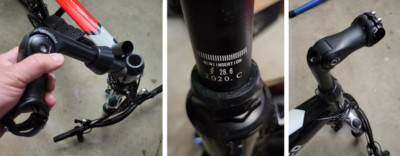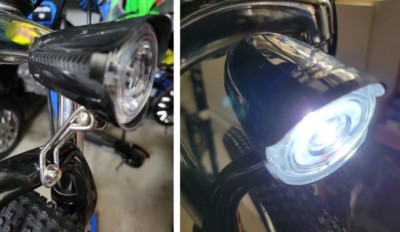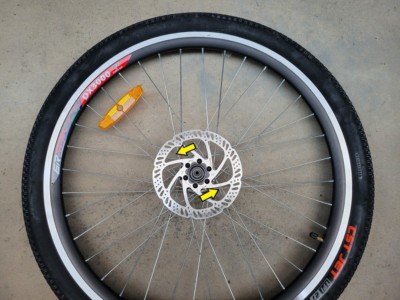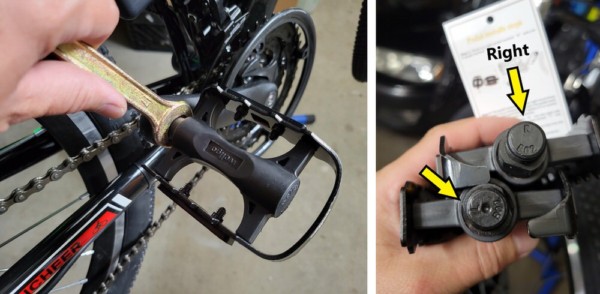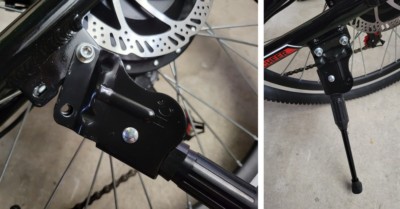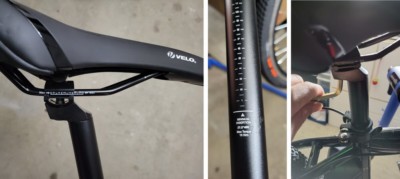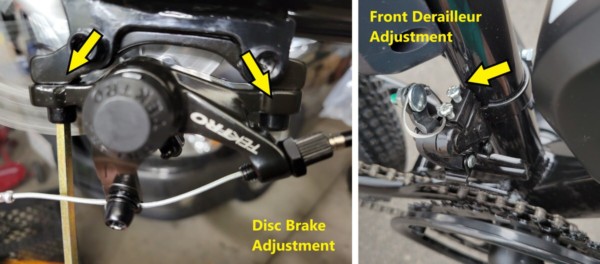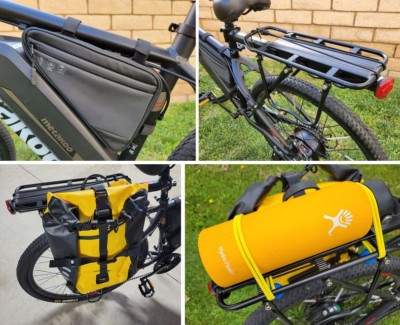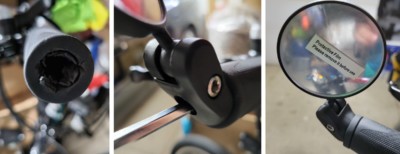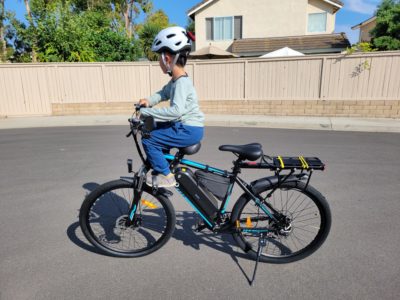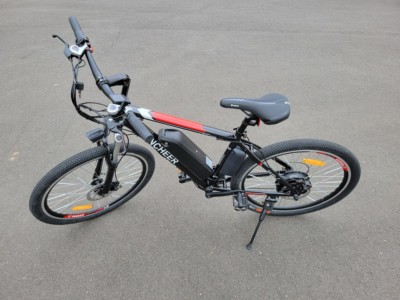Ancheer Electric Mountain Bike (26″, 21-Speed) (Dynamic Red Line, AM001907/AN-EB001)
Pros
- Rapid, smooth, silent acceleration
- Detachable, long-range 450Wh battery with lock
- Strong 500W motor with 3-level PAS
- Shimano, 21-speed gears
- Mountain bike look with electronic horn, headlight
Cons
- No digital display to show speed, trip meter, etc.
- Electric wiring could be improved for a cleaner look
- Heavy at 50 lbs
- Some assembly required
- Very limited accessory mounting options
Contents
Powerful eBike?
Electric bikes changed me, a former rider who preferred manual pedaling for exercise and health reasons, because they have allowed our family to venture out longer distances and visit more places. My brother’s family had since joined our outings and amusingly, he had come to like my Metakoo Cybertrack 100 mountain eBike more and more. He originally was going to buy a Metakoo, too, but eventually asked me to evaluate the 26″ Ancheer AM001907/AN-EB001. Its specs looked much better on paper, addressed some of the shortcomings I criticized the Cybertrack 100 for, but came with its own issues.
The below is my list of must-haves for a battery-powered bicycle. We will go over the reasons why later.
- Decent motor to aid with steep inclines
- 21 speeds/gears for tackling difficult, uphill climbs
- Pedal Assist System (PAS)
- Rides and looks like a normal mountain bike
- Detachable, large battery for long rides and convenient charging
So, what did I think of the Ancheer AM001907/AN-EB001 (Dynamic Red Line) electric mountain bike after riding it for a couple days? It was harder than I thought.
Bike or Scooter?
Electric scooters are more nimble to move around with — and in some cases, more fun — but local laws may prevent them from going onto the same paths as electric bicycles. Most can also be carried around more easily due to their more compact size and lighter weight. Personally, I prefer bikes because they are safer to operate, can (usually) go onto the same places that mechanical bicycles can operate, are (generally) allowed to carry an additional passenger, and if the battery runs out or fails, you can still pedal around. A scooter would stop to function without a battery.
In A Nutshell
Like the Metakoo Cybertrack 100, the awkwardly named Ancheer AM001907/AN-EB001 (Dynamic Red Line) is no Santa Cruz mountain bike and I would never trust my life to a relatively new brand going down the steep, rocky hills without worrying whether the frame or wheels would hold up to abuse. But comparing a $700 electric bike to a professional one that costs 10x more (but weighs nearly the same at 50 lbs) is unfair. The Ancheer checked all my must-haves AND addressed the shortcomings of the Metakoo: a powerful motor, 450Wh detachable battery, 21 Shimano gears, pedal assist, mountain bike style, and electronic horn and headlight.
The very rapid, smooth acceleration afforded by its 500W motor (nominally 43% more powerful than the Cybertrack) evoked feelings of both fear and exhilaration. The battery, too, holds 20% more capacity that could translate to longer distances and provide an endless amount of power to the horn and headlight. Ancheer’s stem adds an advantage with its variable height and angle adjustment to accommodate different rider heights and styles.
The shipping package was well-protected, some assembly was required, and Ancheer had made a YouTube video available that did a much better job than Metakoo of explaining how to put together the front 26″ wheel, handlebar, and accessories. If you had never built a bike before, it would be possible to do so on your own with some patience, but an experienced person could easily assemble the entire product with ease. All the parts were already pre-tuned, but some small adjustments were still necessary to ensure the front disc brake did not rub and the 3-speed gears properly shifted. You may consider taking your new bike into a professional shop as needed.
Despite both bicycles sharing a very similar look and feel, including a fork (front) shock suspension, there were some things I liked more about the Metakoo upon much closer examination. The Metakoo Cybertrack simply looks more refined. Ancheer’s exposed, electrical cables were tied along the down tube, up the seat tube, and into the space-robbing control box that sat right below the seat. The Cybertrack had them professionally tucked away through a large side hole in the down tube itself, providing a cleaner appearance and better protection of the cables, but that would also invite liquids, dust, and rust to eventually damage the frame.
Other subtle downsides of the Ancheer included the handlebar controller not having a digital display to show speed and mileage, and its rear wheel’s skewer was already at maximum stretch to accommodate any additional accessories. The latter could easily be replaced with a third-party skewer of desired length (like the BOB 145mm), but I did not feel like taking the rear wheel off to do so. My brother should do it himself if he wanted to tow a bike trailer. Additionally, the Ancheer’s battery did not have a built-in switch to turn on/off like the Metakoo and its included 84W AC wall charger was standard like other eBikes I had looked at. That was where the Metakoo held a leg up over its competition: its 168W charger could fill up its battery in half the time. Whether a manual power switch and fast-charging capability are must-haves is debatable, but they certainly are nice-to-haves.
Ancheer’s aluminum alloy frame looks and feels sturdy, but again, I would not trust it with hardcore, rocky downhill rides, though the mechanical disc brakes performed well for quick, controlled stops. The heavy, Lithium-Ion battery enclosure is waterproof, could be securely locked to the frame with a pair of keys, and has a button to show charge levels in 25% increments. Its charging port is protected with a water resistant cover.
Tip: The less the motor is engaged, the greater range, battery life, and exercise you will have during the ride.
The brushless motor was turned on with the handlebar-mounted controller, and battery capacity was displayed in 20% increments. Horn and headlight could both be activated independently whether the power was on or off. There were 3 assistance levels controlled via the +/- buttons and about 20 mph (as confirmed with a smartphone GPS) was reached with a 190 lb bicyclist. The manufacturer claims support for up to 330 lbs, and the frame should accommodate riders between 5’2″ – 6’3″ tall (roughly the same as the Metakoo). Cranking the throttle on the right-side handle engaged the motor for when you wanted temporary assistance: the more it was turned, the higher the assist and faster the speed.
Keep in mind that prolonged use of the motor at maximum performance could overheat it. Ancheer claims a range of “25-45 miles” under pure electric mode. This should translate to about 40-55 mi via pedal assist. The Pedal Assist System (PAS) is useful for when you want to pedal with a small amount of electronic help. The less the motor is engaged, the greater range and battery life (and exercise) you will have during the ride.
So, which bike was better? That was a really difficult decision to make. It ultimately came down to preference. My brother loved the power and acceleration of the Ancheer, but the rapid speed increase often elevated my heart rate far too much while trying to ensure a safe ride for my young children sitting inside the bike trailer. Metakoo’s cleaner look was my preference as I primarily used it for manual pedaling, engaging the motor only for climbs. Furthermore, the Metakoo’s rear wheel skewer was long enough to mount the component to connect the bike trailer to. The Ancheer would have needed to have its skewer replaced with a longer one. Fast-charging was possible with Metakoo’s, but honestly, the fact that I had only used 25% of the battery on a 25 mi ride (where the motor was only used to assist with towing 40-95 lbs on climbs) makes this feature a mute point for probably most people.
Both the Ancheer and Metakoo were able to accommodate the Shotgun Kids MTB Child Seat for when a 2-5 year old child wanted to ride up front. My wife and I have been grateful as parents for the pedal assist that has enabled us to ride longer distances with children and heavy weights in tow.
Note: The Googo SY26 eBike is also a GREAT option.
What’s Good? What’s Bad?
Pros
- Smooth, rapid, silent acceleration with brushless motor
- Nominal (average) power: 500W. Rated (maximum) power: 750W
- Top speed: 20 mph, tested (California speed limit is 20 mph)
- (4) Power modes
- Fully electric: No pedaling necessary
- PAS – Pedal Assist System: Get assistance while pedaling (“low”, “mid”, “high”)
- Motor off: Move bike with the power of your own legs ;-)
- On demand: Turn handlebar throttle to manually increase speed and motor assist level
- Battery: 450Wh Li-Ion (36V @ 12.5Ah) (Buy Replacement Battery)
- Detachable with Lock and 2 keys for more convenient charging
- These types of batteries have a 500+ cycle lifespan and lose about 20-25% capacity after every 500 cycle
- Waterproof
- IPX4 water resistance – “Resistant to water splashes from any direction”
- Bikeable in rain but do NOT go through water that is high enough to reach the motor or battery!
- 84W wall charger (2A @ 42V)
- Manufacturer claims empty to 100% in 5-6 hours. Gyroor C3 took 4.5-6 hours with its 84W brick. Metakoo Cybertrack 100 in 3-4 hours with its 168W
- Range: 25-45 mi on fully-electric (according to manufacturer), 40-55 mi on pedal assist modes (my estimate)
- Approx. 110 mi with occasional pedal assist based on my Metakoo 25 mi ride with motorized help on uphill climbs (while towing 195 lb rider, 40-95 lbs cargo, and 46 lb bike itself)
- Shimano 21 speeds (3 front, 7 rear)
- When the battery is out, the higher number of gears will allow easier, more effective, manual pedaling
- Dual, mechanical disc brakes for faster, more controlled stopping
- Front shock suspension for smoother, comfortable handling, although there is no rear shock absorber
- LED Control Panel
- Displays battery level (20% increments) / motor assistance amount (“Mode” = off, “low”, “mid”, “high”)
- When motor assistance level is set to off, motor does not turn on, and you will pedal fully manual. It also enables the Power on Demand throttle on the right-hand side handlebar
- Displays battery level (20% increments) / motor assistance amount (“Mode” = off, “low”, “mid”, “high”)
Serial number is etched into the upper, front part of the stem tube for registration with local police to aid with recovery
- Arrived nearly fully assembled
- Took 18 mins to finish build
- Attach stem, handlebar, pedals, front wheel, kick stand, seat post, front headlight, rear reflector, and make small, tuning adjustments
- Stem angle and height are adjustable
- Took 18 mins to finish build
- Aluminum alloy frame with rider support for up to 330 lbs, according to Ancheer
- Can accommodate 5’2″ – 6’3″ biker height with its quick-release seat post
- 26″ Tires (26 x 1.95 tube) for more controlled, comfortable rides
- Uses Schrader valve with recommended pressure of 40-65 psi
- Built-in headlight and horn powered by the battery
- Weight: 50 lbs, similar to Gyroor C3 and a non-electric Santa Cruz Heckler
- Well-written, illustrated manual
- Tools included
Cons
- Some assembly required
- Those not well-versed with bike building may struggle a bit, especially if some tuning needs to be performed. A YouTube video shows the major steps
- Not built for advanced mountain biking
- LED Controller does not display speed, odometer, and other digital trip information
- Acceleration may be too rapid for some due to its 500W motor
- Electric wiring could be managed and hidden better for a cleaner look
- Rear does not have shock suspension
- Heavy at 50 lbs, though similar in weight to the Gyroor C3 and a non-electric Santa Cruz Heckler
- Very limited mounting options on the frame, such as for a water bottle cage or tire pump
- Control box underneath seat saddle takes up additional space
- Rear wheel skewer length cannot accommodate more accessories without replacing it with a longer, third-party one
- 84W AC wall charger cannot fast-charge the battery
- Was not sure if fast-charging with Metakoo’s 168W brick was safe and so I did not test
- Top tube may be too wide for child seats made for traditional bikes
- Shotgun Kids MTB Child Seat can expand to fit nearly any frame thickness
Tips
Maintenance
- Before first use, charge the battery fully
- Covered charging port is on the removable battery itself
- AC charging brick LED: Red = Charging. Green = Full
- Lithium Ion NMC batteries are known to be volatile and could catch on fire
- Do not charge overnight or unsupervised for prolonged periods of time. Stop charging once full
- Do not leave the bike in full sun or below freezing
- Keep battery charged at 50% or more to prolong battery’s 500+ cycle lifespan. Try to never let it drain completely
- Lithium-Ion NMC batteries lose about 20-25% of capacity after every 500 charging cycle
- Before riding, check the tire pressure (40-65 psi) and tighten any loose screws
- Ensure seat post is locked and tight
Operations
- Motor: Enable it by pressing the “Power” button on the control unit
- Pedal the bike, and you will feel the motor assisting (Pedal assist/PAS)
- Throttle the accelerator by the right-side handle, and the motor will fully take over (Power on demand)
- Note: This only works when “Mode” is off (not “low”, “mid”, or “high”)
- The more you turn, the faster the bike will go
- To power off the motor so you would only be able to pedal manually, press Power (Pedal only) or set “Mode” to off on the control unit
- Manual power assist: Press and hold “-” button for 2 secs to activate motor at low speed
- Helps with walking the bike uphill
- As battery neared empty, I noticed that maximum speed gradually lowered
- Do not brake hard. Doing so could make you painfully tumble, skid, and/or wear out the tires
- Be aware of unexpected obstacles. I tumbled once while mountain biking and was hurt quite badly. It was not fun
Aircraft Transport
Most, if not all, airlines prohibit electronic scooters and bikes that do not meet specific criteria. United Airlines, for example, allows collapsible ones whose battery is both removable and below 300 Wh. Southwest Airlines is more restrictive at 160 Wh. This bike’s battery is 450 Wh. Lithium-ion batteries are known to be volatile, and the higher their capacity, the more risky they are. Check with the airlines, TSA, and FAA for more details.
Bike Assembly
Here are some installation tips for those assembling their first bicycle. First, look at the below diagram to identify the major bike parts, then watch the Ancheer-made YouTube video found right after.
Bike Repair Stands
I use a repair stand to help with assembly and maintenance. SereneLife SLBKRS3 has a maximum load capacity of 66.7 lbs — enough to carry most electric bikes without falling over.
For easier maintenance or assembly, a bike repair stand can save a lot of time and back pain. Be sure to get one that can hold up your bicycle’s weight.
Bike Parts
Installation Video
Step-By-Step
Have included tools ready. Remove all protective material.
Attach stem (pointed forward), clamp the handlebar, and secure the headlight. Pay attention to the front fork: it faces forward. Screw the headlight onto it. The handlebar should be secured with the 4 bolts in alternating, opposite order. It is very important the bolts are securely tightened to prevent handles from coming loose while riding.
Place Quick Release skewer through front wheel. There is a spring on each end with the narrow part facing inward toward the bike. Fasten wheel to the front fork. The arrows on the disc brake should be pointing in the same direction as the ones found on the side of the tire.
Attach pedals to the crank arms. Note the “L” and “R” label on each, respective pedal and use a wrench to securely mount them in the appropriate direction to the crank arms.
Check derailleur protector. You may have to pull the protector a bit until it hovers nicely over the derailleur. It should be cleared enough for the derailleur to freely switch gears.
Attach kickstand, install seat post and saddle, then inflate tires. Tires are sized 26 x 1.95 (26″), use Schrader valves, and should be inflated to 40-65 psi.
Attach the tail reflector, adjust the seat post to the proper height (legs should be slightly bent at a 160 degree angle while seated and with foot on pedal at its lowest position), and do not lift the seat post beyond its maximum height line. Finally, fine tune disc brakes, brake handles, and gear shifters as needed.
Programming
I did not borrow the bike from my brother long enough to check whether the control unit could have its program options changed, like Power Assist level ratios and maximum speed limiter.
Motor Bike Laws
I first learned about laws governing motorized scooters when reviewing the Joyor X5S, and unfortunately, they were (and still are) not straight-forward. There had been a number of accidents involving scooters hitting pedestrians or riders hurting themselves. I get it. Laws are there to protect people from each other and themselves, especially from irresponsible individuals.
Electric bikes can result in severe injuries or death with their high speeds.
Surprisingly, the laws governing electric BIKES are much more lax. They are very similar to non-motorized bikes, in fact! There are different classes of eBikes. This Ancheer falls under the lower-speed Class 2 with a maximum of up to 20 mph, and as such, can be used on Class 1 bike paths in California. All 3 classes can ride on the protected, one-way Class 2 bike lanes found on streets and highways. Be sure to check with your local regulations. Some States categorize eBikes as mopeds or motor vehicles.
- Class 1: PAS-only with no throttle. Max assisted speed: 20 mph
- Class 2: PAS and throttle. Max assisted speed: 20 mph
- Class 3: PAS-only with no throttle. Max assisted speed: 28 mph
California Law
Disclaimer: I AM NOT A LAWYER. Please consult your local city, police department, and/or legal professional for advice.
The following is my interpretation of how I understand the law. It has been shortened to only point out parts that I found interesting or noteworthy.
- Does NOT require riding with a Driver’s License or Instruction Permit (eScooters require them!)
- No license plate required
- Passengers are allowed as long as the bike was designed for it
- Can ride on existing bike infrastructure
- Speed limited to 20 mph
- Follow most of the same laws as non-motorized bicycles
- Helmet required for riders 17 years and younger
- No minimum age limit
Accessories
Some accessories I recommend for this bike for added convenience and safety:
- Yttao (Triangle) Bike Storage Bag: Holds mini tire pump, replacement tubes, and bike repair tools
- Rear Bike Rack: Enex, Dirza, or Vincita – For use as a luggage carrier or seat for a second person
- Rear rack seat cushions
- Rhinowalk Pannier Cargo Bag: A 27L, waterproof, very visible bike, laptop, and shoulder bag for a bike rack
- Ball Bungees: To fasten cargo more securely to the rack, such as my favorite Hydro Flask water bottles that can hold ice for days
- Salzmann 3M Spoke Reflectors: For increased visibility in the dark
- Bar End Bike Mirrors (like BriskMore, Tagvo, or Zacro): To see behind you
- Kootu Folding Pedals: To take up less storage space and not get snagged on things
- Burley Trailer Coupler: So trailer can be switched to another bike (ie. bike failed or ran out of battery)
Kids Bike Seats
See my Shotgun Kids MTB Seat (Review) and why I chose it over trailers, tow bars, and rear seats for quick, short rides. It has become one of my favorite additions for providing front-seat thrills to my kids.
Final Thoughts
Ancheer AM0019079/AN-EB001‘s more powerful, 500W motor and higher capacity, 450Wh battery gave it a definite edge in sheer strength and acceleration over the previous eBikes I had reviewed. It also included a built-in headlight and horn that were powered by the very same battery, and like all the eBikes I had worked with, it had its maximum speed limited to 20 mph to keep within legal guidelines. The way the electrical cabling was run underneath the down tube, up the seat tube, and into the bulky control box made it not look as clean as my own Metakoo Cybertrack 100. However, because the wiring did not flow through a large side hole in the down tube like the Metakoo, it should make it much more resistant to damage by dust, water, and by extension, rust.
I wished the handlebar-mounted control unit had a digital display to show speed, odometer, power-assist level, and other useful information, but some of that could be addressed by adding a third-party speedometer. Also keep in mind that the rear wheel’s skewer would need to be replaced with a longer one if you wanted to attach additional components like those required for towing bike trailers.
I very much appreciated the ability to remove the battery for much easier charging at home or work without having to bring the entire bike inside. Additionally, the battery itself could be securely locked to the frame to minimize the risk of theft. Shifting between the 21 gears was seamless with Shimano derailleurs, and the disc brakes performed as expected for controlled stops.
Despite the shortcomings, the Ancheer bike was quite a powerful one to ride. Its rapid, smooth acceleration made my heart race every time with both excitement and fear of having gone too fast, and that was exactly the kind of bicycle my brother fell in love with. As for me, I stuck with my Metakoo Cybertrack even with the minor flaws it came with.
Note: The Googo SY26 eBike is also a GREAT option.
Where To Buy
- Ancheer AM001907 Electric Bike (Dynamic Red Line, AN-EB001)
- Ancheer AM001907 Replacement Battery
- Accessories
- Yttao Triangle Bike Storage Bag
- Rear Bike Rack: Enex, Dirza, or Vincita
- Rear rack seat cushions
- Ball Bungee Cords | Rhinowalk Pannier Cargo Bag
- Salzmann 3M Spoke Reflectors
- Bar End Bike Mirrors: BriskMore, Tagvo, Zacro
- Hydro Flask Insulated Water Bottles
- Burley D’Lite 2-Seat Bike Trailer/Stroller
- Additional Trailer Coupler so Burley can be switched to another bike (ie. bike failed or ran out of battery)
Related Posts
- Reviews
- HeyBike Cityrun: Beautiful, 26″ electric cruiser bike with 500W motor, 7 speeds (21mph)
- Polarna M4: 20″ foldable, electric bike with 750W motor, 8 speeds (30mph+), and 4″ fat tires
- Jasion EB7: 20″ foldable electric bike with 3″ fat tires, 7 speeds, and can accommodate 5’1″ – 6’2″ tall riders
- Googo SY26: 26″ electric mountain bike with 21 speeds, large informative LCD, electronic headlight and horn, and solid build
- Metakoo Cybertrack 100: 26″ electric mountain bike with 21 speeds and a clean look
- Macwheel Ranger 500: Comfortable, 7-speed, electric cruiser for city commutes
- Gyroor C3: Single speed, electric, semi-foldable, and priced fairly low
- How to Quickly Teach a Child to Ride a Bike (Balance With No Training Wheels)
- Bike USA Stabilizer Wheels for Adult Bicycles

